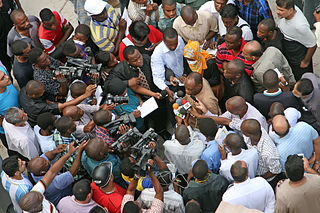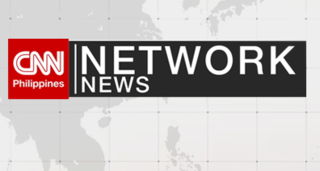
Cable News Network (CNN) is a multinational news channel and website headquartered in Atlanta, Georgia, U.S. Founded in 1980 by American media proprietor Ted Turner and Reese Schonfeld as a 24-hour cable news channel, and presently owned by the Manhattan-based media conglomerate Warner Bros. Discovery (WBD), CNN was the first television channel to provide 24-hour news coverage and the first all-news television channel in the United States.

The Emergency Alert System (EAS) is a national warning system in the United States designed to allow authorized officials to broadcast emergency alerts and warning messages to the public via cable, satellite and broadcast television and both AM, FM and satellite radio. Informally, Emergency Alert System is sometimes conflated with its mobile phone counterpart Wireless Emergency Alerts (WEA), a different but related system. However, both the EAS and WEA, among other systems, are coordinated under the Integrated Public Alert and Warning System (IPAWS). The EAS, and more broadly IPAWS, allows federal, state, and local authorities to efficiently broadcast emergency alert and warning messages across multiple channels. The EAS became operational on January 1, 1997, after being approved by the Federal Communications Commission (FCC) in November 1994, replacing the Emergency Broadcast System (EBS), and largely supplanted Local Access Alert systems, though Local Access Alert systems are still used from time to time. Its main improvement over the EBS, and perhaps its most distinctive feature, is its application of a digitally encoded audio signal known as Specific Area Message Encoding (SAME), which is responsible for the characteristic "screeching" or "chirping" sounds at the start and end of each message. The first signal is the "header" which encodes, among other information, the alert type and locations, or the specific area that should receive the message. The last short burst marks the end-of-message. These signals are read by specialized encoder-decoder equipment. This design allows for automated station-to-station relay of alerts to only the area the alert was intended for.
Breakfast television or morning show is a type of news or infotainment television programme that broadcasts live in the morning. Often presented by a small team of hosts, these programmes are typically marketed towards the combined demography of people getting ready for work and school and stay-at-home adults and parents.

HLN is an American basic cable network. Owned by CNN Worldwide, the network primarily carries true-crime programming, as well as limited live news programming.

Television news in the United States has evolved over many years. It has gone from a simple 10- to 15-minute format in the evenings, to a variety of programs and channels. Today, viewers can watch local, regional and national news programming, in many different ways, any time of the day.
Aaron Brown is an American broadcast journalist most recognized for his coverage of the September 11 attacks for CNN. He was a longtime reporter for ABC, the founding host of ABC's World News Now, weekend anchor of World News Tonight and the host of CNN's flagship evening program NewsNight with Aaron Brown. He was the anchor of the PBS documentary series Wide Angle from 2008 to 2009. He was a professor at the Walter Cronkite School of Journalism and Mass Communication at Arizona State University from 2007 to 2014.
Live television is a television production broadcast in real-time, as events happen, in the present. In a secondary meaning, it may refer to streaming television where all viewers watch the same stream simultaneously, rather than watching video on demand.

A news ticker is a horizontal or vertical text-based display either in the form of a graphic that typically resides in the lower third of the screen space on a television station or network or as a long, thin scoreboard-style display seen around the facades of some offices or public buildings dedicated to presenting headlines or minor pieces of news. It is an evolution of the ticker tape, a continuous paper print-out of stock quotes from a printing telegraph which was mainly used in stock exchanges before the advance of technology in the 1960s.

WDIV-TV is a television station in Detroit, Michigan, United States, affiliated with NBC. It serves as the flagship broadcast property of the Graham Media Group subsidiary of Graham Holdings Company. WDIV-TV maintains studio facilities on West Lafayette Boulevard in Detroit, making it the only major television station in the market with offices and studios within the Detroit city limits. Detroit's other television stations are all based in the suburb of Southfield; WDIV's transmitter is, however, located on Greenfield Road in Southfield.

KXAS-TV is a television station licensed to Fort Worth, Texas, United States, serving as the NBC outlet for the Dallas–Fort Worth metroplex. It is owned and operated by the network's NBC Owned Television Stations division alongside Dallas-licensed Telemundo station KXTX-TV. The two stations share studios at the CentrePort Business Park in eastern Fort Worth; KXAS-TV's transmitter is located in Cedar Hill, Texas.

News broadcasting is the medium of broadcasting various news events and other information via television, radio, or the internet in the field of broadcast journalism. The content is usually either produced locally in a radio studio or television studio newsroom, or by a broadcast network. A news broadcast may include material such as sports coverage, weather forecasts, traffic reports, political commentary, expert opinions, editorial content, and other material that the broadcaster feels is relevant to their audience. An individual news program is typically reported in a series of individual stories that are presented by one or more anchors. A frequent inclusion is live or recorded interviews by field reporters.

Broadcast journalism is the field of news and journals which are broadcast by electronic methods instead of the older methods, such as printed newspapers and posters. It works on radio, television and the World Wide Web. Such media disperse pictures, visual text and sounds.
KHOU is a television station in Houston, Texas, United States, affiliated with CBS. It is owned by Tegna Inc. alongside Conroe-licensed Quest station KTBU. The two stations share studios on Westheimer Road near Uptown Houston; KHOU's transmitter is located near Missouri City, in unincorporated northeastern Fort Bend County.
KWTV-DT is a television station in Oklahoma City, Oklahoma, United States, affiliated with CBS. It is the flagship broadcast property of locally based Griffin Media, and is co-owned with MyNetworkTV affiliate KSBI. The two stations share studios on West Main Street in downtown Oklahoma City; KWTV-DT's transmitter is located on the city's northeast side.

KTEN is a television station licensed to Ada, Oklahoma, United States, serving the Sherman, Texas–Ada, Oklahoma market as an affiliate of NBC, The CW Plus, and ABC. The station is owned by Lockwood Broadcast Group, and maintains primary studios on High Point Circle in northwestern Denison, Texas, with secondary studios at the Ardmore Energy Center on Merrick Drive in northwestern Ardmore. Its transmitter is located along State Highway 7 in rural northeastern Johnston County, Oklahoma.

WIBW-TV is a television station in Topeka, Kansas, United States, affiliated with CBS and MyNetworkTV. Owned by Gray Television, the station maintains studios on Commerce Place in west-southwestern Topeka, and its transmitter is located on Windy Hill Road in Maple Hill.
In broadcasting, local insertion is the act or capability of a broadcast television station, radio station or cable system to insert or replace part of a network feed with content unique to the local station or system. Most often this is a station identification, but is also commonly used for television or radio advertisements, or a weather or traffic report. A digital on-screen graphic, commonly a translucent watermark, may also be keyed (superimposed) with a television station ID over the network feed using a character generator using genlock. In cases where individual broadcast stations carry programs separate from those shown on the main network, this is known as regional variation or an opt-out.
The Cable News Network (CNN), is an American basic cable and satellite television channel owned by the CNN Worldwide division of Warner Bros. Discovery. Upon its launch, CNN became the first channel to provide 24-hour television news coverage, and was the first all-news television network in the United States.

CNN Philippines Network News, or simply Network News was the first flagship evening newscast of CNN Philippines. It aired seven days a week at 6:00pm PST.

NewsNet is an American news-oriented free-to-air television network and newscast production company owned by Bridge News, LLC, which itself is owned by Manoj Bhargava's Bridge Media Networks. The network is structured to broadcast a tightly-formatted 30-minute newswheel 24 hours a day, incorporating freshly-updated information that covers various areas of interest. Breaking news stories are updated constantly as they develop and new information becomes available.












